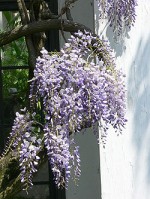
Japanese wisteria is a deciduous flowering vine native to Japan but was introduced into the US in the 1830s and has become invasive from new Jersey to Indiana, south to Florida and Louisiana. The vine grows up to 35’ or more and climbs by twining clock-wise. It can be grown as a multi-stemmed shrub or small tree or on an arbor or wall. The bright green leaves are 12-16” long and pinnately compound with 9-19 leaflets ¾” to 2.4” long. In early to mid spring, pendent racemes of flowers 1.5’-3’ long appear. The pea-like flowers are fragrant and may be blue, violet, pink, or white. They give way to brown velvety 6” long seed pods that mature in summer and may persist into winter. Japanese wisteria has longer racemes than any other wisteria and is admired for its spectacular appearance when in full flower. USDA Hardiness Zones 5-9
The following native is recommended as an alternative:
American Wisteria (Wisteria frutescens)
Growing 15-40’ long, this deciduous flowering vine is quick to produce flowers when young. Although its racemes of purple-blue to white flowers are only 6” long the overall effect of the vine when flowering is beautiful. Native to bottomlands, streambanks, swamps, and woodland borders in Virginia and Missouri, south to Florida and Texas. USDA Hardiness Zones 5-9